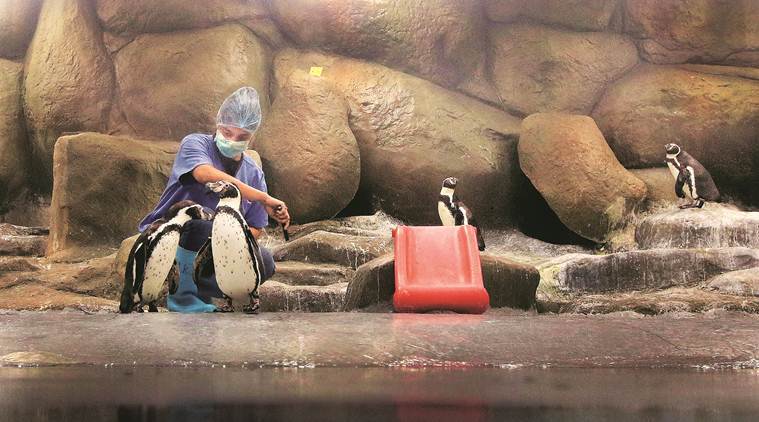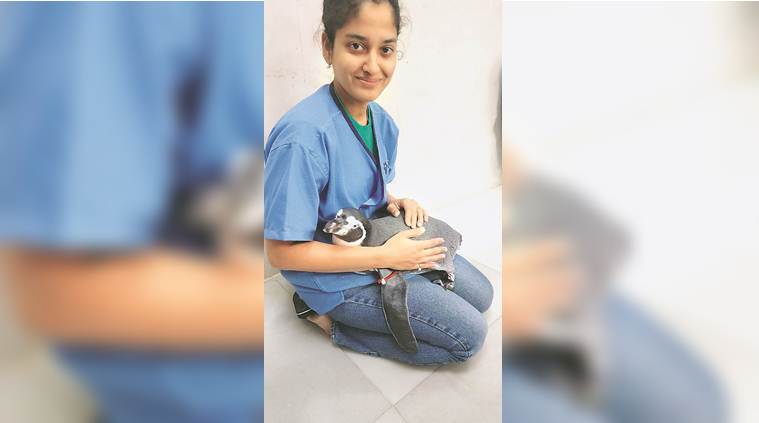 It’s all fun and games till it’s time to feed the birds — that is when Kale has to bear an occupational hazard. (Express photo/Amit Chakravarty)
It’s all fun and games till it’s time to feed the birds — that is when Kale has to bear an occupational hazard. (Express photo/Amit Chakravarty)
They like to chase the thin stream of red light from the laser pointer. And trail the sunlight that bounces off mirrors. So when veterinarian Dr Madhumita Kale runs the laser device in circles over their heads, the Humboldt penguins at Mumbai’s Veermata Jijabai Udyan in Byculla mimic the movement, rapidly swivelling their heads, their eyes set on the rays.
It’s all fun and games till it’s time to feed the birds — that is when Kale has to bear an occupational hazard. “They bite when you feed them or while they are playing,” she says, pointing to scratches — the latest is an angry welt on her right arm.
Eight penguins — Donald, Daisy, Popeye, Olive, Flipper, Bubble, Mr Molt and Dory — were brought to the Mumbai zoo from Seoul, South Korea, two years ago. Dory’s death due to bacterial infection, in October 2016, led widespread criticism of the decision to bring the penguins here. Last month, the penguins were again in the news when Flipper and Mr Molt’s chick died of “liver dysfunction” a week after its birth on August 15. “The penguins were quite sad that night. We could hear them,” recalls Kale, who has been with them since their arrival. However, she says, they have moved on. “They haven’t been depressed as mentioned in some reports,” she says.
The mornings begin on a cheerful note with the seven penguins awaiting breakfast. At 8.30 am, when the 28-year-old veterinarian arrives at the cavernous glass building that houses the 1,500-sq-ft penguin enclosure — the latest addition to the 157-year-old zoo — piles of chopped anchovies, herring and mackerel are readied. The enclosure has been cleaned by three zookeepers who work in shifts.
“In the beginning, I had to supervise everything — cleaning of the glass wall, the pool, etc. Now it’s all taken care of,” says Kale. There are three other doctors in the team as well.
Dressed in medical scrubs, a face mask and gumboots with her initials on it, Kale spends the next couple of hours ensuring that the penguins get their prescribed diet. “Usually two of us go in. That way the birds don’t crowd around one of us,” she says. On most days, Donald, one of the male penguins, tries to grab most of the food, Kale adds.
 “In the beginning, I had to supervise everything — cleaning of the glass wall, the pool, etc. Now it’s all taken care of,” says Kale. (Express photo/Amit Chakravarty)
“In the beginning, I had to supervise everything — cleaning of the glass wall, the pool, etc. Now it’s all taken care of,” says Kale. (Express photo/Amit Chakravarty)
The caretakers fling pieces of fish into the pool running along the enclosure’s length. “They like to be fed in the water,” she says. The enclosure has been designed to resemble the conditions of the wild — artificial rocky outcrops painted with non-toxic paint. “The penguins can climb up and down the rocks and get their exercise,” she says. A sandy beach couldn’t be created due to “space constraints”.
Around 9 am, after breakfast, the first group of about 20 curious visitors trickle in, making their way past the smart card-powered turnstiles while Kale and her colleagues give the birds some exercise. Out come the laser pointers again and they begin their chase. Their ungainly waddle leaves the audience delighted.
“At times we hold mirrors to reflect sunlight from the windows into the enclosure. They like chasing after the ball of light as well,” smiles Kale. After an hour of playtime, Kale returns to her office, across the corridor from the enclosure, to tackle paperwork.
“Several reports have to be sent to the Brihanmumbai Municipal Corporation (BMC) every day — how much food the penguins have eaten, their vital parameters, mating details, cleanliness of the enclosure and the temperature inside,” she explains.
The 12 CCTV cameras inside the climate-controlled enclosure — the temperature is between four and 24 degrees Celsius — help the team monitor the birds round the clock, and check for signs of illness. “These animals do not exhibit any outward symptom of sickness as doing so in the wild makes them vulnerable to predators. The symptoms appear only when things get serious, and by then, it is often very late,” she says.
In the afternoon, Kale accompanies senior veterinarians, including zoo director Dr Sanjay Tripathi, for a routine examination of the 388 animals, birds and reptiles in the zoo. Before the penguins became the main attraction here, it was the one-horned rhino, Shiva, that enjoyed celebrity status among visitors. He died of cancer in 2014.
Kale joined the zoo two years ago when she returned to Mumbai with a Master’s in Veterinary Science from Massey University in Auckland, New Zealand, where she had worked with penguins. “I had heard that the zoo was acquiring penguins. The team approached me and I joined,” she says.
Since then, the veterinarian has faced a wide array of questions from visitors, especially: why are these penguins so small? And, where is the snow? “People associate penguins with snow. But these Humboldt penguins are indigenous to the temperate South American coasts of Peru and Chile, and grow only up to 70 cm. They weigh no more than 6 kg,” she says. Four television screens inside the enclosure and one in the visitor’s area play videos of the places where Humboldt penguins hail from. There is also information about their origin, habitat and lifespan.
By 4 pm, half an hour before the day ends, it is dinner and playtime. But as visitors stand glued to the glass wall to watch them in action, the birds don’t oblige, standing stock still.
“That’s their resting posture. Visitors often assume they are asleep. But the penguins only get active post 6 pm after their meal,” says Kale, entering the enclosure before calling it a day.
As Donald and Mr Molt vie for Kale’s attention, a father demands that the penguins dive into the pool for his two daughters to watch. The children wait patiently, pressing their faces against the glass. Another visitor tries to take a photograph, ignoring the signboard that says, “Flash photography is prohibited”. The BMC guards and a policewoman stationed in the visitor’s area ask him to put his phone away. Flash photography adds to the stress of the birds and has implications on their health, moulting and mating patterns, says Kale.
Kale now cradles Donald on her lap and teases him with a long twig. He follows the twig, making a few unsuccessful snaps before grabbing it. As she begins to leave, Kale pauses at the door and turns to find Mr Molt waddling away with the twig. Gently plucking it away from its beak, Kale returns to see off the last visitors.